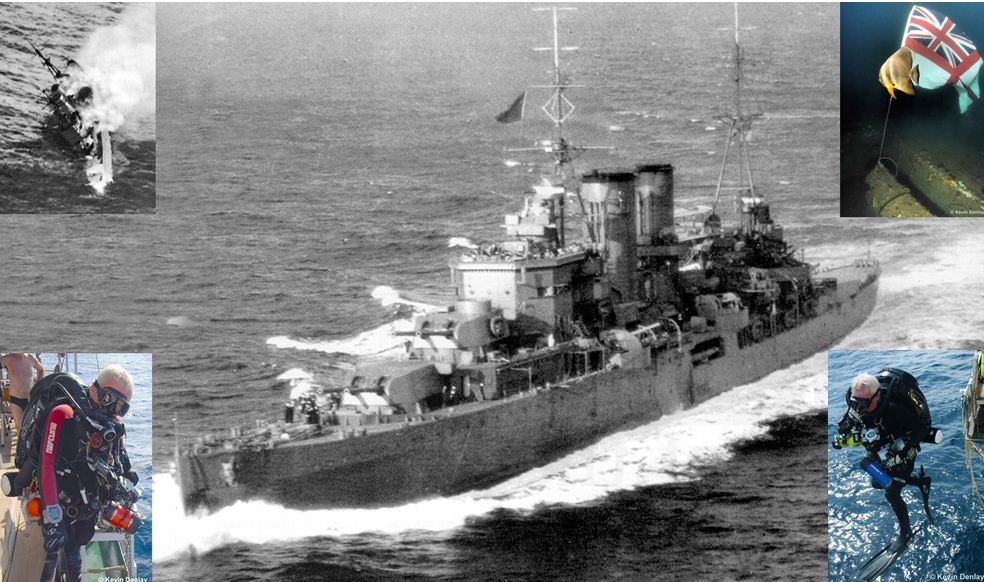
WW2 Shipwreck exploration by Kevin Denlay: “Going back in time and bringing the ships back to life” – PART 1
Aircraft wrecks, Interviews, Shipwrecks, WW2, WW2 Pacific Treasures, WW2 WrecksBy Pierre Kosmidis – August 2017
Photos by Kevin Denlay (unless otherwise noted)
Historical Photos: Kevin Denlay Collection
READ PART TWO: The WW2 shipwrecks that disappeared: Underwater explorer Kevin Denlay’s interview on the lost fleet of the Pacific – PART 2

As the saying goes “only a diver knows the feeling of discovering and diving on a virgin wreck”. Few underwater explorers worldwide have been directly involved in such an impressive array of WW2 shipwrecks located and identified, as Kevin Denlay has.
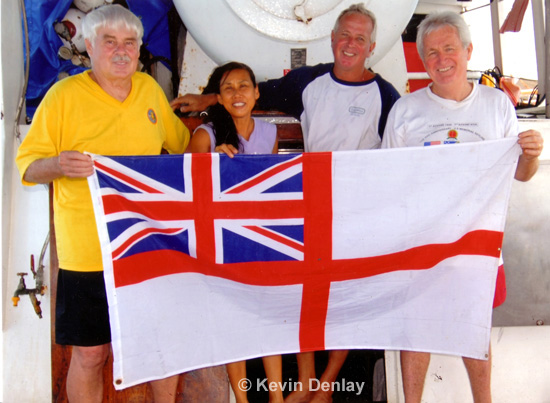
Kevin Denlay tells www.ww2wrecks.com in PART 1 of his interview that “after all, it’s one thing to look at historical photos of old or missing warships, it’s another thing entirely to actually dive them and see and touch the real thing”.

Being one of the pioneers of technical scuba diving, Kevin Denlay has documented WW2 Wrecks that were submerged in oblivion for decades, setting the record straight on many occasions:
“Not only were many of the wrecks we discovered often found far from where they were supposedly sunk, we would often find that the damage stated in the historical record did not always coincide with what we saw on the wrecks themselves, that is more or less, or just different damage than what had until then been ‘officially’ believed or recorded”.

Kevin Denlay’s involvement in diving expeditions that discovered HMS Exeter, the Imperial Japanese Navy heavy cruiser Haguro, the light cruiser of the Royal Netherlands Navy Hr. Ms. De Ruyter, among other WW2 wrecks, are significant, not just because of the wrecks themselves but, as Kevin Denlay says, “one of the main things the discovery of missing ships also does is give the families of the deceased, and to the few remaining survivors of the sunken ships, some closure as to where their friends and loved ones lay”.

READ PART 1 OF KEVIN DENLAY’S INTERVIEW:

Please tell us a bit about your background as a diver and how did you start looking for WW2 wrecks?
Well, although I have been around the ocean most of my life, and did some free-dive spear fishing for a while in my teens, I did not start scuba diving until rather late in life, that is 1989 when I was 38 years old (as in the interim I had been too ‘busy’ with any free time having fun surfboard riding and windsurfing).
But I progressed quickly from there, as it was the early days of the so-called ‘technical diving’ revolution and in 1991 I participated in only the second nitrox diver course conducted in Australia (where I then lived).

Then in 1993 I went to the USA for several months training and, first, did a ‘deep air’ course (to 73 metres / 240 feet) with Hal Watts at his famous Forty Fathom Grotto (because helium was generally unavailable at the locations I was diving at the time).
 PHOTO: Mirja Denlay
PHOTO: Mirja Denlay
During the same trip I also became a nitrox diver instructor with the International Association of Nitrox and Technical Divers (IANTD) and was also cave diver and trimix wreck diver trained by Tom Mount and Bret Gilliam (as trimix – a helium based breathing mixture allowing for much deeper dives than with just regular ‘air’ – still wasn’t being taught in Australia at that time).
Around the same time I also started my own diving business called Alternate Diving Services, orientated specifically to train nitrox divers (and later all levels of technical diving) and offer mission support for technical / deep diving expeditions.

Over the next couple of years I spent some time each year diving and undertaking more instructor training in the USA and progressed through a series of courses to become a trimix instructor and then instructor trainer with both IANTD and Technical Diving International (TDI), the premier technical diver training agencies at the time.
I also participated in the first ever worldwide recreational rebreather diver / instructor course on the Draeger Dolphin Semi-Closed Circuit Rebreather (or SCR) unit conducted in 1995 by the late TDI’s Rob Palmer in the Bahamas, but found the semi-closed circuit technology not really suited to my needs so did not progress much further down the SCR road.

However, I eventually went on to become a Closed Circuit Rebreather (or CCR) diver and instructor on the Mk15.5 CCR and continued diving that unit exclusively from 1999 onwards.
In the interim prior to becoming a fully committed CCR diver I also taught various technical diver and instructor courses in assorted locations around the world.
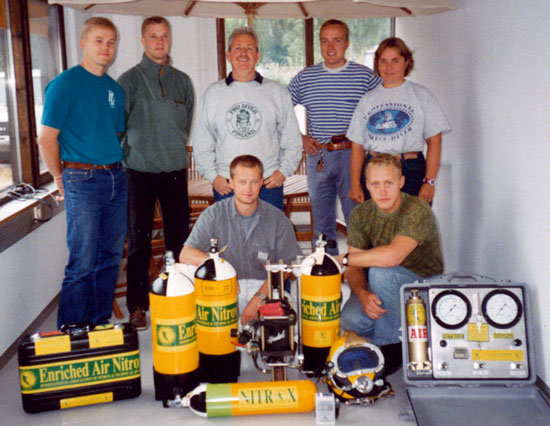
For instance, as far as I am aware, I taught the first nitrox diver and instructor course in Scandinavia (in Finland in 1994), and went to Bikini Atoll in 1996 just prior to its actual ‘opening’ for recreational divers and trained the operators there in technical diving.
I also taught courses on Guadalcanal in the Solomon Islands, where in 1995 we made the very first scuba dive on the USS Atlanta which is still the deepest diveable wreck in the Solomon’s at 130 metres / 430 feet maximum depth (at the bow).

Subsequently during the last half of the 1990’s I spent as much time as I could diving the many WWII wrecks off Guadalcanal and Tulagi, an adjacent island (nearby where we discovered several sunken Japanese Navy ‘Mavis’ flying boats, or Kawanishi H6K’s).

And during one of our expeditions in March 1998 my wife Mirja conducted what was then the deepest wreck dive by a woman anywhere in the world (on the USS Atlanta to 115 metres / 377 feet).
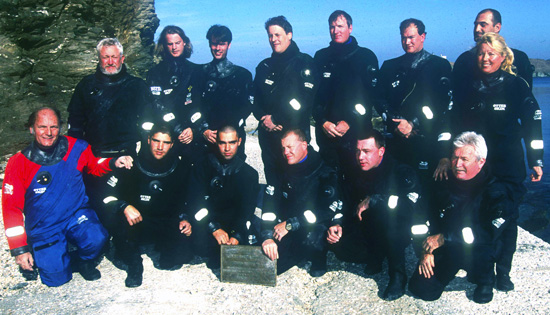
I also participated in Kevin Gurr’s 1997 HMHS Britannic expedition, the first technical diving expedition to dive the wreck since Cousteau first discovered and dived her in 1976.
And in 1998 I was elected a Fellow of the Explorers Club (headquartered in New York, USA) and eventually conducted Expedition “Job 74”, a 2007 survey of the wrecks of HMS Prince of Wales and HMS Repulse off the west coast of Malaysia; in 2008 a survey of the wreck of HMS Exeter in the Java Sea entitled “Java Sea Revisited – HMS Exeter Expedition” and Expedition “Operation Dukedom” a 2010 survey of the wreck of HIJMS Haguro, off the west coast of Malaysia in the Malacca Strait, among a series of other expeditions and documentations.
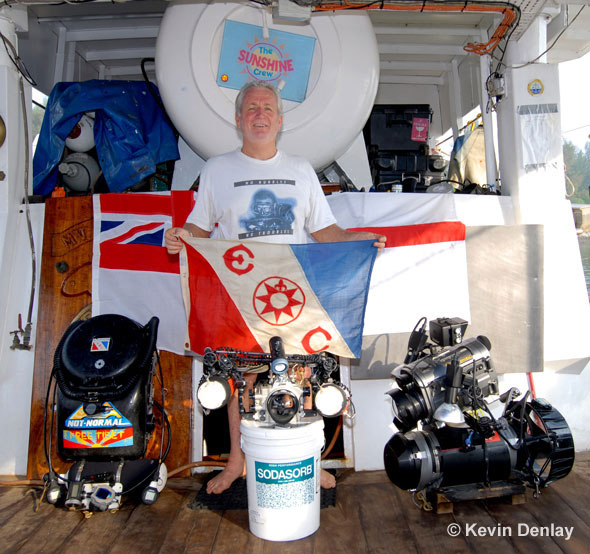
For instance, what is considered the most extensive Marine Forensic Analysis of the wreck of HMS Prince of Wales ever conducted was based on the above survey report and two follow up dives and It was very fortunate the survey and analyses was conducted when it was as the wreck has since been extensively damaged by illegal salvors, with all the propellers and shafts removed along with other damage to the hull, which completely destroyed the original ‘evidence’ that had sat untouched for 70 odd years.

So prior to beginning my explorations in the Java Sea in 2002 I had spent much of the previous nine years travelling the world, both teaching technical diving and exploring shipwrecks in various locations and had become well and truly enthralled by the ‘time-capsule’ like nature of shipwrecks and the stories they told.

As to why I specifically become involved in shipwreck exploration; primarily because of their mysterious nature encapsulating history, and to help bring that history back to life!
READ PART TWO: The WW2 shipwrecks that disappeared: Underwater explorer Kevin Denlay interview on the lost fleet of the Pacific – PART 2
That is, the often valiant stories behind many of the sunken ships and the men who served on them and the exciting stories the wrecks themselves tell, which I might add is not always in accord with the historical record.

Not only were many of the wrecks we discovered in Asian waters often found far from where they were supposedly sunk, we would often find that the damage stated in the historical record did not always coincide with what we saw on the wrecks themselves (i.e. more / less or different damage than what had until then been ‘officially’ believed or recorded).
And diving on them was like going back in time and bringing the ships back to life, or least putting their names back in the spotlight as it were.

And the then undiscovered wrecks in the Java Sea came from the beginning months of WWII in the Pacific when Japan was on the ascendant, and everywhere the Allies were losing ground (and ships!) and being pushed back.
Hence the Java Sea naval battles have become somewhat overlooked in the grand scheme of WWII, and nothing was known about most of the shipwrecks there.

So after Guadalcanal I set my sights on the Java Sea and became involved searching for those undiscovered wrecks from this earlier period in the Pacific War aboard the dive vessel MV Empress in 2002.
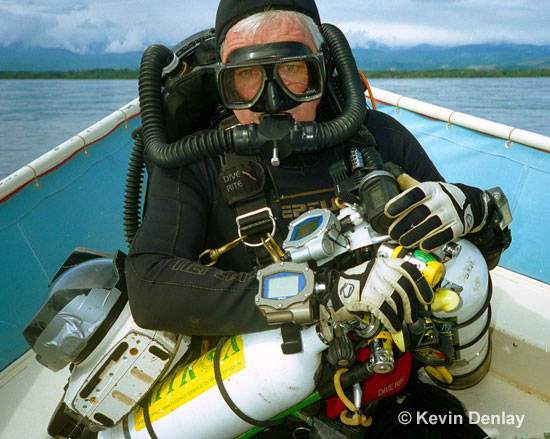
And I have to say, it was a real privilege over the years (from 2002 through 2010) to have been involved in the discovery of, and first dives on, so many virgin (i.e. undived / untouched) shipwrecks in the Java Sea and off Malaysia aboard Empress, and the adventures we had exceeded all my expectations.

What was the most important discovery you made and why?
To me it has to be discovering the wreck of HMS Exeter in 2007, partly because it took us five years of dogged searching just to find her!
And when she was lost she was already a famous ship for her part earlier in the war from her battle with the German ‘pocket battleship’ Admiral Graf Spee in the South Atlantic off Montevideo.

In fact HMS Exeter was so badly damaged during that battle that she needed extensive refitting back in the UK before being sent out to her ultimate demise in Asia.

So finding her was a real accomplishment, especially given she was so far from all the ‘official’ positions given for her loss and that we had spent so much time searching for her.

On the other hand, discovering HIJMS Haguro (in the Malacca Strait in 2003, and also not near her ‘official position’) was also rather special as she had sunk Hr. Ms. De Ruyter, which we had discovered in 2002, and had a hand in sinking HMS Exeter also.
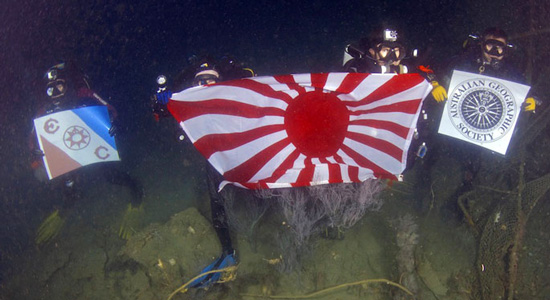
However, I really can’t put into words the feeling of elation that embraces one when making a new shipwreck discovery, as there is just something really really special about making the first dive on a previously undiscovered shipwreck.

As the saying goes “only a diver knows the feeling” of discovering and diving on a virgin wreck.
So my abiding memories, from all the warship wreck discoveries we made, is to have literally journeyed into the past and ‘walked the decks’ of those famous warships sunk in the heat of battle so many years ago.
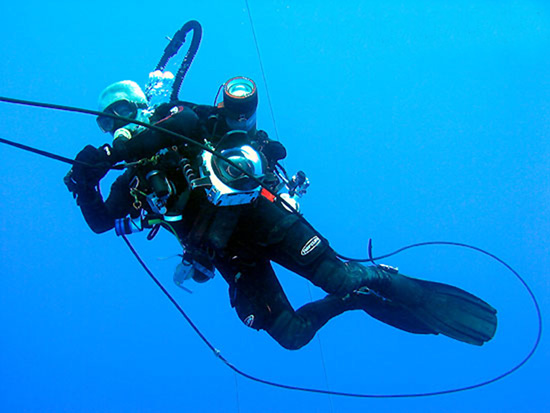
They were nothing less than awe inspiring sights and a real time capsule into the past. But now, with the 2016 discovery of the complete salvage of most of them, they are gone forever!

Diving at a wreck which is also the grave of sailors, what are your thoughts when you explore it?
Of course thoughts of those lost go through your mind, but that’s really something I think more about when on the surface, not so much during a dive. And then I try to find out if there are any survivors still alive, which there often were.
Then again, as I said, diving on the WWII warships wrecks we discovered was like travelling back in time, you’re actually seeing for the first time a ship that has not been seen by human eyes since its sinking, which at the time of our discoveries varied between fifty eight (Haguro) and sixty five (Exeter) years ago.
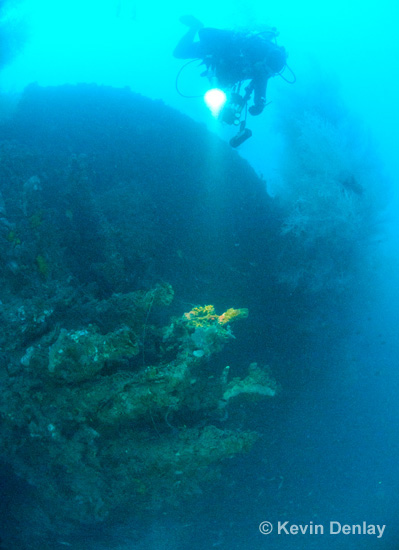
And most of the wrecks we discovered were, surprisingly, in remarkably good condition, that is very little deterioration save for the battle damaged they had sustained when being sunk, and thankfully, as yet untouched by the salvors hand.
And here you are now walking the decks (well swimming actually) just as those sailors did all those years ago when their ship was in battle and was sunk. After all, it’s one thing to look at historical photos of old or missing warships, it’s another thing entirely too actually dive them and see and touch the real thing.

And if it is a wreck that your group has just discovered and are the very first to dive on, then it’s a real thrill.
And one of the main things the discovery of missing ships also does is give the families of the deceased, and to the few remaining survivors of the sunken ships, some closure as to where their friends and loved ones lay.

What other wrecks have you been involved in the discovery of, and of all the wrecks which were you favourites to dive?
Well, to be honest, since my time aboard MV Empress from late 2002 onwards we discovered so many virgin wrecks, both from WWII and more ‘modern’ times that weren’t warships that I can’t remember all of them. On one expedition alone we discovered over twenty virgin undived / uncharted wrecks in the Java Sea, and that was just one expedition out of many!

Besides the ones previously mentioned, the other warship wrecks of importance in the Java Sea I have been involved in the discovery of and first dives on were the Dutch light cruiser Hr. Ms. Java and the destroyer Hr. Ms. Kortenaer; and the British destroyers HMS Electra and HMS Encounter.

Also in the Java Sea the large Japanese minelayer HIJMS Itsukushima and the American submarine USS Perch (SS-176), while in the Malacca Strait the Japanese light cruiser HIJMS Kuma. Unfortunately the visibility was generally low on many of these wrecks, and although not that deep in the grand scheme of things they were often quite dark, although on occasion we would get some good visibility days.

Back home in Australia in 2000 some friends and I (including the late John Riley) discovered the SS Keilawarra, a steamship sunk in 1886 in tragic circumstances off the mid north coast of New South Wales in 75 metres of (often ‘sharky’) water, and as we had several more possible locations to check that day – and with Riley and I the only mixed gas divers aboard – I called the toss of the coin right and made the very first dive on her solo.
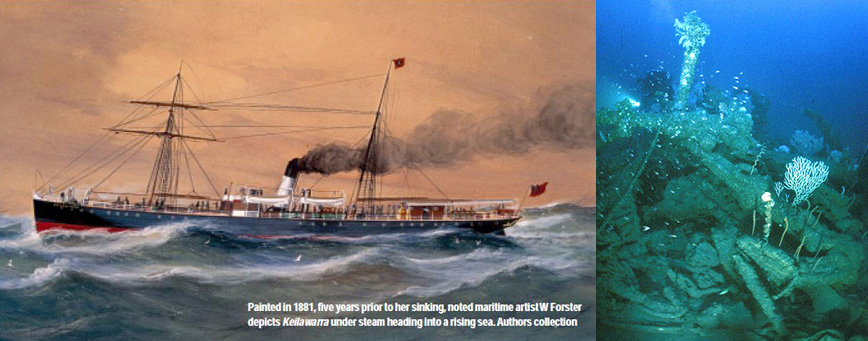
Then in 2005 my friend Ian Eberhardt and I made the first dive on what we thought was just another small reef (of the many one often dives when searching for wrecks), but it turned out to be the ballast stones and other artefacts from a very old wooden shipwreck with a copper sheathed hull that was believed to be the Brig Missie, which sank off the south Queensland coast in 1866. Ian even found the bell!

We handed over the bell and some other artefacts we collected to the Queensland Maritime Museum, hoping for a positive identification, but unfortunately the bell was so corroded that a positive ID could not be made. Thankfully none of these wrecks were too deep, not like off Guadalcanal, as all the ones I’ve mentioned here were in the 50 metre / 164 feet to 75 metre / 246 feet range.

As for my favourite dives, although not necessarily in any particular order, it would have to be HIJMS Haguro, HMS Exeter, Hr. Ms. Java and of course, USS Atlanta. Haguro was a rarity for a big warship though, a heavy cruiser sitting completely upright!

Exeter on the other hand was tilted well over to starboard on an angle of about 75 degrees and Java was completely over on her starboard side. Atlanta on the other hand lay on her port side. The visibility varied considerably from visit to visit at each site but I have had some truly awesome dives with good visibility on all four.

However, all the wrecks had their own story to tell, and we struck good or at least adequate visibility on most wrecks, save for HIJMS Kuma which seemed to be habitually poor. Thankfully during the right months of the year the Java Sea and the waters off the east and west coasts of Malaysia are generally calm, but every now and then you would miss a day of diving during a passing storm (or two!), or have to wait out the abating of the ocean current, which could be very strong at times, before a dive could take place.

READ PART TWO: The WW2 shipwrecks that disappeared: Underwater explorer Kevin Denlay interview on the lost fleet of the Pacific – PART 2
